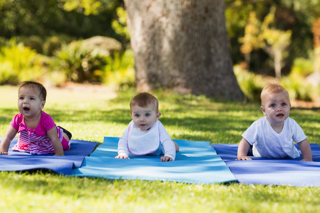
A toddler’s first steps are a milestone event parents eagerly await. However, early walking does not mean your child is advanced. In fact, it can mean your child’s brain has missed some vital developmental steps that will cause problems later.
Two main types of crawling
Experts have observed 25 unique combinations of body parts used by babies to move across the ground, however the two main types are belly crawling and criss-cross crawling on hands and knees.
Belly crawling. About half of babies begin crawling by keeping their belly against the floor. These children typically start crawling earlier than those who start out on hands and knees because belly crawling takes less strength and balance.
On occasion, babies use this method of crawling right up until the moment they walk. Others move to criss-cross crawling before walking.
Criss-cross crawling or hands and knees crawling requires limbs from opposite sides to coordinate with each other. A baby alternates arms and legs, getting the arm on one side to meet the floor at the same time the opposite leg does.
Also called contra-lateral, or cross-lateral crawling, this diagonal style of movement is vital in the development of an important pathway in the brain that belly crawling does not impact — the corpus callosum.
Criss-cross crawling is vitally important to brain development
The corpus callosum is a band of nerve fibers between the hemispheres of the brain. Criss-cross crawling stimulates the corpus callosum to develop in a balanced way, facilitating the hemispheres of the brain to communicate.
A baby’s cross lateral movements work both sides of the body evenly and involve coordinated movements of the eyes, ears, hands, feet, and core muscles. This helps support cognitive function, problem solving, and ease of learning.
Crawling helps hip sockets form
Crawling also serves as physiological stepping stone to walking. The crawling muscle actions start to reshape the hips, pulling them inward and forward. As the baby gets stronger she becomes better positioned to lift her body and balance for walking.
Crossing the midline of the body
In criss-cross crawling a baby can also move a limb to the opposite side of the body, such as touching the right hand to the left shoulder. This type of movement is key for developing vision, hearing, learning, and integration of reflexes.
Other ways crossing the midline helps babies:
- Increases lower back strength in preparation for upright positioning.
- Prepares the ankles for the flexion used in walking.
- Exercises spinal rotation.
- Strengthens hand-eye coordination.
What about other crawling methods?
You may notice your baby using other combinations of limbs and movements to move across the floor. Scooting on the bottom, using one foot or knee to push or pull, crab crawling, leapfrogging, or even repetitive rolling may indicate difficulty coordinating the cross-body movement necessary for hands and knees crawling.
This may occur for various reasons and it indicate your child is missing out on important developmental inputs.
If your baby doesn’t seem to want to crawl, find a functional neurology practitioner who can help you learn fun, supportive, nonjudgmental ways to encourage crawling so your baby can gain all the brain benefits.
Be wary of pushing your baby to be upright
Some babies don’t crawl on hands and knees and some recent parenting trends will tell you crawling isn’t important, but that doesn’t mean it isn’t vital for development.
For instance, one popular trend that can inhibit development of reflexes and motor function is to prop babies in upright holding devices too often.
Placing a baby habitually into an upright position she otherwise couldn’t get into on her own, whether in a device or by hand, can make it harder for her to meet normal developmental milestones.
This doesn’t mean you should never prop your baby up. It is fine to carry your baby upright, hold her at face level for interaction, or sit her in a high chair for eating, but make sure to give her plenty of time on the floor so she can develop her brain-body connections.
How can I help my baby learn to crawl?
The following suggestions can help encourage crawling:
- Give your baby as much floor time as possible. Exploration helps babies try new movements.
- Allow your baby to discover sitting and standing completely on her own. This way she will build strength and coordination necessary for crawling on hands and knees.
- Minimize holding or propping your baby upright to prevent her from developing excess muscle tension that makes crawling difficult.
- Avoid popular trends that tell you crawling is not important.
If your baby arches her back a lot, does not want to curl up and snuggle, does not use both arms and legs, uses rolling more often than crawling, or does not seem interested in moving, seek assistance from a functional neurology doctor.
Science has known for years that children who miss the vitally important crawling stage may exhibit learning difficulties later in life.
Crawling on hands and knees is vitally important for proper development of the brain and body.
Allow your baby to crawl for as long as she wants, and when she walks on her own she will take the benefits forward with her throughout life.
Contact our functional neurology office for more advice.



Latest from the Blog
Autoimmune Disease Management with EBOO Therapy
July 17, 2024Autoimmune diseases, characterized by the immune system attacking the body’s own tissues, present significant challenges in treatment and management. Extracorporeal Blood Oxygenation and Ozonation (EBOO) therapy offers a promising adjunctive approach to managing autoimmune conditions. Functioning similarly to a dialysis machine, EBOO filters the blood to remove toxins and pathogens that may trigger autoimmune responses. […] Read more
Latest from the Blog
Detoxification and EBOO Therapy: Optimizing Cellular Health
Detoxification plays a crucial role in maintaining optimal health in today’s toxin-laden environment. Extracorporeal Blood Oxygenation and Ozonation (EBOO) therapy offers a sophisticated approach to detoxifying the bloodstream and enhancing overall well-being. Operating similarly to a blood filtration system, EBOO effectively removes toxins, pesticides, and chemicals that accumulate in the body, supporting the body’s natural […] Read more